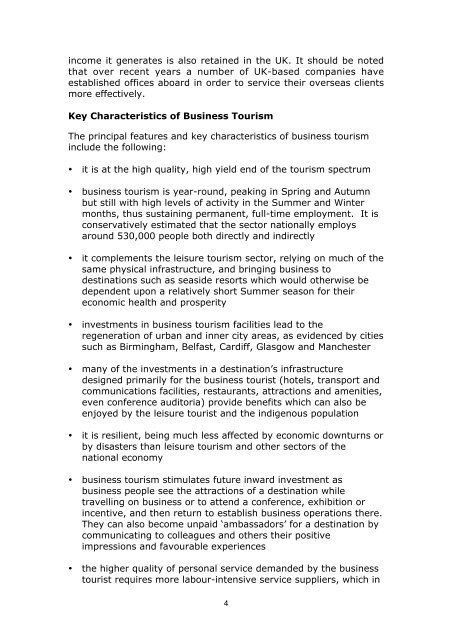Business Tourism Partnership Mission
Business Tourism Partnership Mission
Business Tourism Partnership Mission
Create successful ePaper yourself
Turn your PDF publications into a flip-book with our unique Google optimized e-Paper software.
income it generates is also retained in the UK. It should be noted<br />
that over recent years a number of UK-based companies have<br />
established offices aboard in order to service their overseas clients<br />
more effectively.<br />
Key Characteristics of <strong>Business</strong> <strong>Tourism</strong><br />
The principal features and key characteristics of business tourism<br />
include the following:<br />
• it is at the high quality, high yield end of the tourism spectrum<br />
• business tourism is year-round, peaking in Spring and Autumn<br />
but still with high levels of activity in the Summer and Winter<br />
months, thus sustaining permanent, full-time employment. It is<br />
conservatively estimated that the sector nationally employs<br />
around 530,000 people both directly and indirectly<br />
• it complements the leisure tourism sector, relying on much of the<br />
same physical infrastructure, and bringing business to<br />
destinations such as seaside resorts which would otherwise be<br />
dependent upon a relatively short Summer season for their<br />
economic health and prosperity<br />
• investments in business tourism facilities lead to the<br />
regeneration of urban and inner city areas, as evidenced by cities<br />
such as Birmingham, Belfast, Cardiff, Glasgow and Manchester<br />
• many of the investments in a destination’s infrastructure<br />
designed primarily for the business tourist (hotels, transport and<br />
communications facilities, restaurants, attractions and amenities,<br />
even conference auditoria) provide benefits which can also be<br />
enjoyed by the leisure tourist and the indigenous population<br />
• it is resilient, being much less affected by economic downturns or<br />
by disasters than leisure tourism and other sectors of the<br />
national economy<br />
• business tourism stimulates future inward investment as<br />
business people see the attractions of a destination while<br />
travelling on business or to attend a conference, exhibition or<br />
incentive, and then return to establish business operations there.<br />
They can also become unpaid ‘ambassadors’ for a destination by<br />
communicating to colleagues and others their positive<br />
impressions and favourable experiences<br />
• the higher quality of personal service demanded by the business<br />
tourist requires more labour-intensive service suppliers, which in<br />
4




